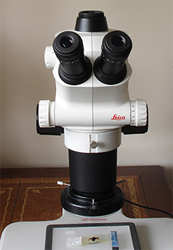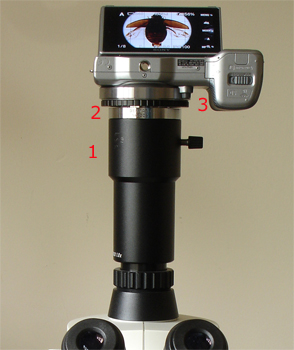 I treated myself to a modern stereo microscope a few years ago, the Leica S8 APO, as my trusty but aged Meiji EMZ-1 lacked a vertical camera port. I've never been entirely satisfied with the Leica purchase for a number of reasons. But I learnt valuable lessons on the merits of different camera
types and their associated adapters for the photo-port, which I share, as other maker's models may bring
up similar options.
I treated myself to a modern stereo microscope a few years ago, the Leica S8 APO, as my trusty but aged Meiji EMZ-1 lacked a vertical camera port. I've never been entirely satisfied with the Leica purchase for a number of reasons. But I learnt valuable lessons on the merits of different camera
types and their associated adapters for the photo-port, which I share, as other maker's models may bring
up similar options.
The Leica has an empty photo-port designed for various cameras with appropriate adaptors. These are illustrated below with comments on their potential pros and cons from my perspective.
Right: The Leica S8 APO 1-8X zoom stereo showing the vertical photo-port which requires a specific Leica adaptor before any type of camera can be attached. Many microscopes offer a working photo-port, e.g. a standard 23.2 mm eyepiece tube or built-in C-mount thread. (The slide subject shown presents the slide at the exact angle for the left tube used for photography in order to ensure subjects are flat across the field of view and in focus.)



Left to right above:
Adaptor for SLR / DSLR shown with a Canon 600D (T3i) body.
1 - The 1.0X adaptor required for photo work (Leica part no. 10445930). This presents a 37 mm ID aperture. May 3rd 2021 correction. This has a lens at its base and is not lensless as initially incorrectly stated.
2 - Leica 2.5X adaptor with internal optics to attach an SLR / DSLR. (Leica part no. 10446175.)
3. Canon EOS T2-mount.
Notice how little of the visual field of view of the insect is captured on the APS-C sensor cf the Sony NEX 5N which captures up to the edge of the eyepiece field of view.
C-mount adaptor with dedicated microscope camera (shown with a 1.4 Mpixel monochrome USB camera to indicate typical sizes).
1 - as above.
2 - Lensless 1X adaptor with male C-mount thread (Leica part no. 541006).
C-mount adaptor with mirrorless consumer camera body shown with a Sony NEX 5N body.
1 and 2 - as above.
3 - Sony NEX to female C-mount adaptor which is very cheap and widely available e.g. on eBay.
The adaptor is slightly recessed so that the flange to sensor distance is exactly the same as for a C-mount camera i.e. 17.5 mm. This ensures parfocality of the visual field with C-mount systems.
This form of attachment while ensuring the correct projection distance is only possible for mirrorless cameras.
The Sony NEX 5N has an electronic first curtain shutter mode to give a vibration free shutter release, an essential feature in my experience. Some mirrorless cameras can be worse than reflex mirror cameras for vibration if hard coupled to a microscope without this feature.
Exploring the options
Adaptor for SLR / DSLR - the first approach tried to use an existing Canon DSLR.
Pros I already had the competent Canon 600D body with APS-C sensor for compound microscope use, so to avoid further camera purchase, I dug deep into the pocket and bought the adaptors to convert the port for SLR / DSLR body use.
A consumer camera with software for complete remote operation including live view image monitoring is useful as the Canon offers and other makers.
Cons Converting a C-mount to 35 mm format can require a number of optical elements and can equate to quite considerable expense, possibly more than alternative camera options (a used Sony NEX 5N for example is considerably cheaper than the SLR adaptor).
In the Leica case the adaptor is very bulky and heavy (not totally obvious from the system diagram until it arrives and is in use).
As the image shows it creates a cumbersome tall system with the camera at an awkward height with its weight at some way from the stereo head support and thus a vibration prone system.
Leica don't declare the field of view of the SLR adaptor but calculate that it's 76% of the optimum fit of the 35 mm frame within a circle. For the APS-C sensor of my Canon 600D it is only 48%. For the 1X setting on the stereo, the visual field diameter is 22.6 mm whereas the camera capture on an APS-C sensor is 8.8 mm horizontal width i.e. a lot of the image field is lost.
The extended magnification also shows as softer images because empty magnification is creeping in on the low NA stereo system.
C-mount adaptor with dedicated microscope camera - a simple elegant solution with suitable microscope camera.
Pros The simplest and cheapest route was to use a lensless 1X C-mount adaptor for a dedicated microscope camera with software.
Many do choose this option for compound and stereo use and there are a wide range of excellent camera models to choose from in a wide price range.
The 1x mount is a good match for the modern large sensors, the adaptor label gives the sensor diagonals for the so-called 2/3" and 1" which are the most suited.
Cons I didn't own a suitable camera (the monochrome camera shown is reserved for near UV 'diatom dotting' work on a compound).
Good value cameras are widely available but I preferred not to adopt this route. I've never really got on with how dedicated microscope cameras work. I can't relate to exposures in milliseconds,
the merits of binning etc. and have never been entirely convinced that microscope cameras keep up with the fast paced modern developments of consumer camera sensors. Dynamic range in particular as microscopy imagery can be very demanding.
C-mount adaptor with mirrorless consumer camera body - current and preferred solution
Pros This maintains the lensless adaptors required for C-mount systems with its modest height.
A mirrorless camera such as the Sony shown can be used for other photo uses unlike dedicated microscope cameras. (I have an adaptor to use my Nikon AI lenses with it.)
The APS-C sensor is somewhat larger than the ideally matched 1 inch sensor but the modest vignetting is useful as can show the whole visual field allowing tight crops to maximise maximum subject coverage, a requirement often sought when imaging under a stereo. May 3rd 2021 comment added. A camera with smaller sensor e.g. micro four-thirds would be a better fit in the circle of view as noted in the forum thread but prefer to capture the full field when using a stereo to allow the tight crops. Circular subjects which tightly fit the circular field for example would be cropped by a smaller sensor.
With modern multi-megapixel cameras some modest cropping still allows more than sufficient pixels to capture all the detail, especially on a stereo with their intrinsically low numerical apertures, which is sacrificed for working distance.
Cons In my case, purchase of a second camera body in another mount was required (the Sony NEX 5N) but as remarked this route if adopted from the outset would have been considerably cheaper than the adaptor to attach the DSLR.
This sort of camera does not offer total remote control with live view image monitoring.
The vignetting is not always ideal, especially if capturing video where would need to crop the field for the film clip to look presentable.
Lessons learnt
If considering a number of different makers' stereo models and if photography is desired, assess the pros and cons before purchase of the entire microscope-camera system for each stereo including the adaptors and pricing with different types of camera.
Don't be initially swayed in choosing a photo system by a camera currently owned, especially if a DSLR. These can be the least suited for photo work on a stereo and can involve cumbersome and expensive adaptors. It may be more cost effective to buy another consumer camera body better suited for the system (or a dedicated microscope camera).
If seeking high quality photography for subjects with fine detail of a size encompassed by the field of view of a typical stereo, the stereo is not a good route. The intrinsically low NA of the optics, especially at the lower mags, give only acceptable results compared with other approaches. These include using long working distance compound microscope objectives on a micro-focussing system coupled with stacking.
Convenience may still make the stereo with camera a route of choice if the highest quality imaging isn't vital. In addition to visual studies, I use my Leica system a lot for one-shot images of various subjects as their main use is for modest sized imagery on the web where the highest quality isn't required.
Comments to the author David Walker are welcomed.